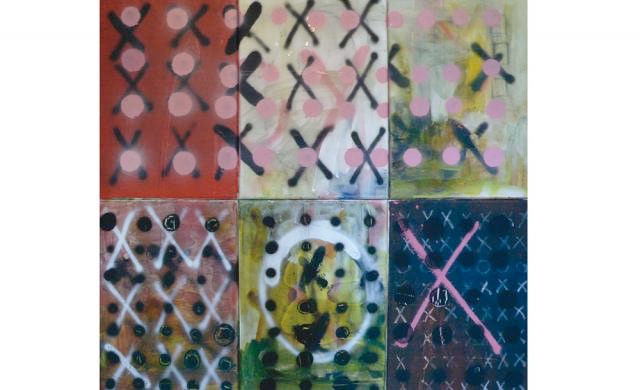-
•
London-born artist, Ann Healey
Ann Healey is back for her 10th solo exhibition with more enigmatic works.
By Belinda Wan | published Sep 06, 2007

Fans of London-born artist Ann Healey need no introduction to her works, as Healey has previously held nine solo exhibitions here.
In her latest exhibition, C502H8, a glorious display of mixed media works await you—filled with scrawly writing, noughts, crosses and a clever blend of contrasting colors. Seeking to reveal life’s truths that lurk beneath the veneer of superficiality that pervades society, Healey takes botox, the latest miracle pills and even collective en block sales as her inspirations. We chatted with her about plastic, Lego and chemical formulas.
What does the title of the exhibition mean?
It’s the chemical formula for a transparent plastic more commonly known as acrylic glass or simply, acrylic.
Are these paintings artistic critiques of the fickleness of society?
I think we live in an ever-changing society. Positive change is an essential component in our evolution. More and more so we have a myriad of possibilities to make a difference—be it to our landscape, thoughts or bodies. I am celebrating that!
What are your obsessions?
Apparently noughts and crosses!
We hear this exhibition is inspired by architecture, graffiti, plastic surgery and Lego. Why are they fascinating?
Architecture will be a perennial favorite in my works as it changes with each generation, governed by economies and artistic tastes. Graffiti is an artistic expression used by artists to deface or add to structures. The juxtaposition of a graffiti artist adding his or her own comment on a building is something that I find interesting, irreverent and exciting. Plastic surgery allows us become our own designers and architects. I loved Lego as a child because it had endless possibilities. Good ideas are timeless and Lego is one of these ideas. Lego teaches all of us that indeed, what goes up, can and does come down.
Why use plastic and was it easy to work with?
I chose plastic because it’s present in almost every single thing we touch and use every day, yet it is often seen in a negative way. I’m all for using plastic responsibly! In the beginning it was challenging to work with.
How would you describe these works?
As three-dimensional paintings.
You use a lot of noughts and crosses. Why?
The noughts and crosses are the repetitive mark-making in this collection—they become the obsessive force in the work. 0 is the beginning and the centre, a shape with infinite sides and has connections with pi, an irrational number. The crosses or x’s are the intersection of two lines, which occurs with any two straight lines. I like that concept! So we have the infinite and the finite together. Sometimes the noughts represent chemical components or pills from a game of Pacman. Noughts and crosses can also represent a kiss, desire or cross-stitch! It’s a way to mark space.
One of your paintings has the words “Obsession” and “Desire” stamped all over it. What do you think is the difference between obsession and desire?
To desire is to want something that you don’t have. Most of us have desires. A little desire can be a strong motivational force. It takes a dedicated person to obsess!
Your favorite painting from the collection and why?
All of the pieces are a derivative of the one favorite in my head.



